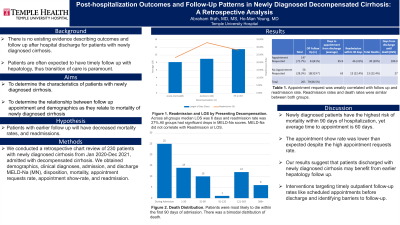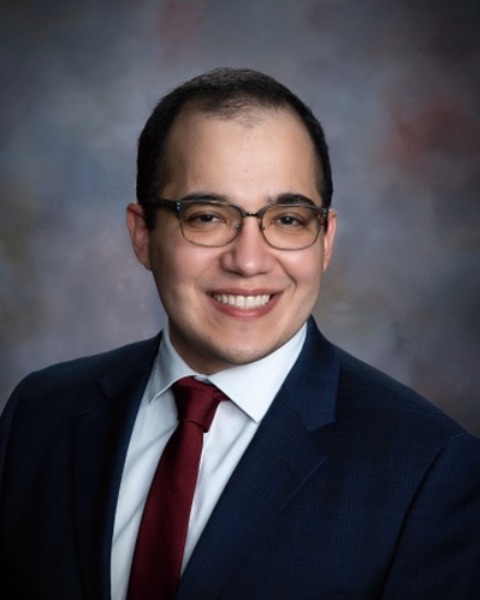Monday Poster Session
Category: Liver
P2433 - Post Hospitalization Outcomes and Follow-Up Patterns in Newly Diagnosed Decompensated Cirrhosis: A Retrospective Analysis
Monday, October 23, 2023
10:30 AM - 4:15 PM PT
Location: Exhibit Hall

Has Audio

Abraham Ifrah, MD, MS
Temple University Hospital
Bala Cynwynd, PA
Presenting Author(s)
Abraham Ifrah, MD, MS, Ho-Man Yeung, MD
Temple University Hospital, Philadelphia, PA
Introduction: There is no existing evidence describing outcomes and follow up after hospital discharge for patients with newly diagnosed cirrhosis. Patients are often expected to have timely follow up with hepatology, thus transition of care is paramount. This study offers insights into potential interventions to increase follow-up success and improve patient care.
Methods: We conducted a retrospective chart review of 230 patients with newly diagnosed cirrhosis from Jan 2020-Dec 2021, admitted with decompensated cirrhosis. We obtained demographics, clinical diagnoses, admission, and discharge MELD-Na (MN), disposition, mortality, appointment requests rate, appointment show-rate, and readmission.
Results: The most common reasons for admission were anemia (27%), ascites (25.7%), and hepatic encephalopathy (HE) (10.4%). Overall, the median length of stay (LOS) was 6 days, and the readmission rate (RR) was 27%. Most common etiology of new cirrhosis was alcohol (Figure 1). Although there was significant reduction of the MN from admission to discharge (p< 0.005), admission MN did not correlate with LOS and discharge MN did not predict readmission. Patients with HE had the highest average LOS (11.5d), while patients with ascites had the highest RR of 33%. There was a bimodal distribution of death, with 72% of all deaths occurring within the first 90 days of admission (Figure 2). The average time to an appointment was ~60 days. The average appointment show-rate was 38.5%, although 70% of patients had appointment requests. RR and mortality were not different between those with appointment requests and those who did not. No differences in outcomes were observed based on race/ethnicity or sex.
Discussion: Newly diagnosed patients have the highest risk of mortality within 90days of hospitalization, yet average time to appointment is 60days. The appointment show rate was lower than expected despite the high appointment requests rate. Our results suggest that patients discharged with newly diagnosed cirrhosis may benefit from earlier hepatology follow up. Interventions targeting timely outpatient follow-up rates like scheduled appointments before discharge and identifying barriers to follow-up.

Disclosures:
Abraham Ifrah, MD, MS, Ho-Man Yeung, MD. P2433 - Post Hospitalization Outcomes and Follow-Up Patterns in Newly Diagnosed Decompensated Cirrhosis: A Retrospective Analysis, ACG 2023 Annual Scientific Meeting Abstracts. Vancouver, BC, Canada: American College of Gastroenterology.
Temple University Hospital, Philadelphia, PA
Introduction: There is no existing evidence describing outcomes and follow up after hospital discharge for patients with newly diagnosed cirrhosis. Patients are often expected to have timely follow up with hepatology, thus transition of care is paramount. This study offers insights into potential interventions to increase follow-up success and improve patient care.
Methods: We conducted a retrospective chart review of 230 patients with newly diagnosed cirrhosis from Jan 2020-Dec 2021, admitted with decompensated cirrhosis. We obtained demographics, clinical diagnoses, admission, and discharge MELD-Na (MN), disposition, mortality, appointment requests rate, appointment show-rate, and readmission.
Results: The most common reasons for admission were anemia (27%), ascites (25.7%), and hepatic encephalopathy (HE) (10.4%). Overall, the median length of stay (LOS) was 6 days, and the readmission rate (RR) was 27%. Most common etiology of new cirrhosis was alcohol (Figure 1). Although there was significant reduction of the MN from admission to discharge (p< 0.005), admission MN did not correlate with LOS and discharge MN did not predict readmission. Patients with HE had the highest average LOS (11.5d), while patients with ascites had the highest RR of 33%. There was a bimodal distribution of death, with 72% of all deaths occurring within the first 90 days of admission (Figure 2). The average time to an appointment was ~60 days. The average appointment show-rate was 38.5%, although 70% of patients had appointment requests. RR and mortality were not different between those with appointment requests and those who did not. No differences in outcomes were observed based on race/ethnicity or sex.
Discussion: Newly diagnosed patients have the highest risk of mortality within 90days of hospitalization, yet average time to appointment is 60days. The appointment show rate was lower than expected despite the high appointment requests rate. Our results suggest that patients discharged with newly diagnosed cirrhosis may benefit from earlier hepatology follow up. Interventions targeting timely outpatient follow-up rates like scheduled appointments before discharge and identifying barriers to follow-up.

Figure: A. Cirrhosis Etiology. Alcoholic cirrhosis was the most common cause of newly diagnosed cirrhosis and was slightly higher than national averages. B. Death Distribution. Patients were most likely to die within the first 90 days of admission. There appears to be a bimodal distribution. C. Average LOS and Readmission Rate for the most common decompensations on admission.
Disclosures:
Abraham Ifrah indicated no relevant financial relationships.
Ho-Man Yeung indicated no relevant financial relationships.
Abraham Ifrah, MD, MS, Ho-Man Yeung, MD. P2433 - Post Hospitalization Outcomes and Follow-Up Patterns in Newly Diagnosed Decompensated Cirrhosis: A Retrospective Analysis, ACG 2023 Annual Scientific Meeting Abstracts. Vancouver, BC, Canada: American College of Gastroenterology.
